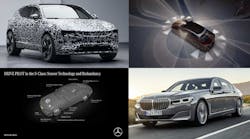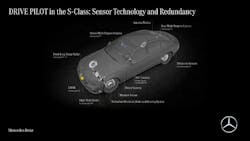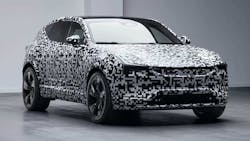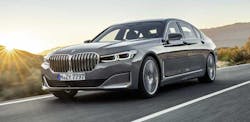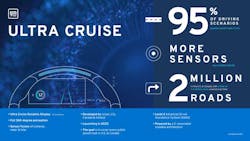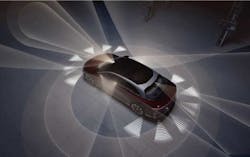What you'll learn:
- Approval and the details surrounding Mercedes' Drive Pilot self-driving system.
- Polestar's and BMW's latest Level 3 automotive efforts.
- Level 3 projects from U.S. automakers GM, Tesla, and Lucid Motors.
Occasionally, a practical solution to a problem emerges faster than the understanding of the problem itself. This is what seems to be happening with Level 3 autonomous vehicles, particularly in Europe.
Take Mercedes-Benz as an example. The Stuttgart-based automaker has been granted regulatory approval in Germany for a new Drive Pilot Level 3 self-driving system (Fig. 1). The system is operable at up to 37 mph (60 km/h) in heavy traffic or congested situations on suitable stretches of motorway in Germany. The basis of the approval is the UN Regulation 157 dealing with automated lane-keeping systems, thus paving the way for offering such a system internationally—if individual countries allow it.
With approval from the German Federal Motor Transport Authority (KBA), Mercedes plans to offer Drive Pilot on its S-Class sedan starting in the first half of 2022. Mercedes said regulatory approval also applies to its EQS electric hatchback, but the automaker didn't say when the system would be available on that vehicle.
The Road Traffic Act of 2017 created a legal framework for Level 3 systems in Germany, but the specific regulations that allowed Drive Pilot to be certified didn't come into force until the beginning of 2021, according to Mercedes.
Drive Pilot Details
On suitable motorway sections and where traffic density is high, Drive Pilot can offer to take over the driving, initially up to the legally permitted speed of 60 km/h. The controls needed for this are located in the steering wheel rim, on the left and right above the thumb recesses. When the driver activates Drive Pilot, the system controls the speed and distance, and guides the vehicle within its lane.
Drive Pilot builds on the sensor suite from the S-Class's Driver Assistance Package. It adds LiDAR as well as a camera in the rear window and microphones, especially for detecting red and blue lights and other special signals from emergency vehicles, plus there’s a wetness sensor in the wheel well. It also incorporates redundant steering, braking, and electrical systems, according to the automaker.
The system employs an HD map that provides a three-dimensional street and environment image. The map data is stored in back-end data centers and updated constantly. Each vehicle stores an image of this map information on board, too, constantly comparing it with the back-end data and updating the local data set if necessary.
Drive Pilot will first be available in Germany and Mercedes says it’s testing the system in the U.S. and China. So far it can only operate on designated highways in Germany, comprising a total of 8,197 miles. It uses the existing suite of sensors that enable other driver-assistance features and includes additional LiDAR sensors, cameras, and a moisture sensor in the wheel well. There are also fail-safes for the steering, braking, and electrical systems.
Mercedes hasn’t yet detailed how or if it plans to seek approval for Drive Pilot in America. For both Level 2 (partial automation) and Level 3 (conditional automation) autonomous driving, a driver is still needed to take control. However, for Level 3, the driver won’t be prompted to take control after a given interval when he or she hasn’t touched the steering wheel.
Polestar’s New E-SUV
Polestar was once a Swedish racing team that was part of Volvo. But in 2017 it became a separate company and has increasingly pulled away from the parent company. Polestar's next model, the Polestar 3, is scheduled to be unveiled this year, and we know that it will be an E-SUV. The automaker also said that the upcoming EV would offer a Level 3 autonomous driving system in the Polestar 3.
The system is expected to be a version of Volvo's planned Ride Pilot, an SAE Level 3 system that will allow drivers to take their eyes off the road and hands off the steering wheel, leaving them free to read or eat with both hands. The automaker has developed this system along with Zenseact (for autonomous driving software), NVIDIA, and Luminar (including Luminar’s new Iris LiDAR sensor) (Fig. 2).
Volvo says that it will extensively test Ride Pilot in California this coming summer—it will only be available in California at first—and of course will be subject to regulatory approval. The upcoming electric successor to the XC90 will arrive on sale later this year, but it may still take a bit more time for Ride Pilot to be activated in the vehicles themselves, which will feature over-the-air updates.
The BMW 7 Series Sedan
BMW’s Level 3 campaign will start with its 2022 7 Series full-size sedan (Fig. 3), which is due in North America in the second half of this year. According to BMW’s Director of Development Frank Weber, we can expect Level 3 automated driving to be featured in the 2023 7 Series. Published reports also indicate an optional upgrade to Level 3 technology will be available for BMW’s just-launched iX electric SUV.
At the moment, BMW’s iX electric crossover is a Level 2 system using radar, a self-cleaning camera, and ultrasonic and driver-monitoring sensors. It’s also 5G-capable. BMW’s iX utilizes an 8-Mpixel front camera to identify pedestrians, other vehicles, and traffic signs, while the front radar reaches 330 yards in front of the car. It has five cameras, five radar sensors, and 12 ultrasonic sensors.
BMW has had input from partner Mobileye (owned by tech giant Intel and a supplier of advanced driver-assistance systems, or ADAS), which plans to bring a new system-on-chip to market designed to equip passenger cars, trucks, and SUVs with autonomous driving powers. Called EyeQ Ultra, it’s purpose-built for autonomous driving. At the recently concluded Consumer Electronics Show (CES), the company said first silicon for the EyeQ Ultra SoC, which is capable of 176 trillion operations per second (TOPS), is expected at the end of 2023, with full automotive-grade production in 2025.
On This Side of the Pond
What’s happening in the U.S.? We are far from inactive on the development and study front, and the last few years have seen numerous experimental self-driving cars. Still, the U.S. doesn’t yet have comprehensive legislation that covers Level 3 cars.
On the SAE scale of self-driving capability, Level 3 refers to systems that allow drivers to take their hands off the wheel and eyes off the road in certain situations. It’s far short of true autonomous driving, though, as the driver still needs to be ready to take back control at any time.
GM’s Ultra Cruise
GM plans to offer its Ultra Cruise ADAS starting in 2023 with Cadillac being the first to introduce the technology. It’s designed to eventually permit hands-free driving in what the company says will be 95% of all driving scenarios (Fig. 4), on roads other than highways, similar to Tesla's efforts to expand its full self-driving (FSD) to city roads and more complex traffic environments.
Ultra Cruise will receive over-the-air updates to expand functionality once launched. This also is similar to Tesla, but it's not expected to be considered an SAE Level 3 system with eyes-off capability.
The system will cover more than 2 million miles of roads at launch in the U.S. and Canada, with the capacity to grow up to more than 3.4 million miles. Users will be able to travel hands-free with Ultra Cruise across nearly every road including city streets, subdivision streets, and paved rural roads, in addition to highways.
Ultra Cruise is powered by a 5-nm, scalable compute architecture future-proofed through GM’s Ultifi software platform and Vehicle Intelligence Platform. Ultra Cruise can add features, functions, and services over time.
Diagnostic and learning systems automatically identify scenarios where Ultra Cruise needs upgrading, triggering data recordings in vehicles equipped with the service. These recordings will then be processed through GM’s back office data ecosystem for continuous improvement of the system.
Ultra Cruise works through a combination of cameras, radars, and LiDAR, developing 360-degree, three-dimensional statistical representations of the environment surrounding vehicles with redundancies in critical areas. Ultra Cruise also incorporates an integrated LiDAR behind the windshield.
Tesla’s Full Self-Driving Beta
Tesla has begun wider rollout of what it calls a Full Self-Driving Beta if drivers have a perfect safety score over 100 miles. The automaker has been rolling out updates to the system for over a year and has introduced driver attention monitoring to help prevent system abuse. It hasn’t indicated that it will offer eyes-off capability as part of FSD, though.
Each new Tesla vehicle is equipped with eight external cameras, 12 ultrasonic sensors, and an onboard computer to provide an additional layer of safety to guide drivers on their journey. Model 3 and Model Y built for the North American market have transitioned to camera-based Tesla Vision, which aren’t equipped with radar and instead rely on Tesla’s suite of cameras and neural-net processing to deliver Tesla’s Autopilot and related features. Model S and Model X continue to be equipped with radar.
Lucid’s DreamDrive
Look, we’re loathe to engage in superlatives, but Lucid Motors’ DreamDrive is by all accounts noteworthy. The system offers more than 30 driver-assistance features, including collision avoidance, Traffic Jam assist, and Highway Assist (Fig. 5).
Lucid’s DreamDrive Pro, the most comprehensive version of DreamDrive, employs up to 32 on-board sensors, a driver-monitoring system, and on-board Ethernet networking, making it among the most advanced ADAS systems in existence. It comprises 14 visible-light cameras, five radar units, four surround-view cameras, ultrasonic sensors throughout the vehicle exterior, and the first consumer application of LiDAR on the market.
This high-speed data network enables four computer gateways—one at each corner of the car—to communicate with each other at gigabit speeds, resulting in a high degree of redundancy for key systems such as steering, braking, sensors, and power. Further redundancy comes by way of Lucid’s novel dual-rail power architecture, which adds an additional layer of assurance in power delivery to vehicle systems.
DreamDrive Pro’s interface uses text, color, and sound to provide drivers with clear information presented on the display. It also utilizes “Surreal Sound,” an immersive 21-speaker system to deliver clear directional alerts. This enhances safety features like Front and Rear Cross Traffic Protection and Autonomous Emergency Braking. Highway Assist blends adaptive cruise control and lane-centering control to help keep Lucid Air vehicles where they belong on the freeway, at a safe distance from the vehicle ahead and those in other lanes.
